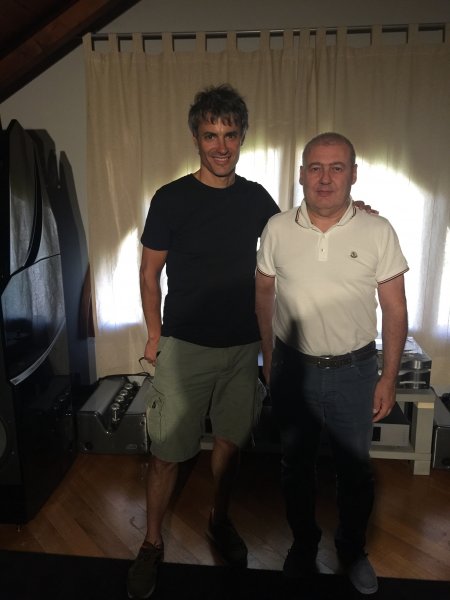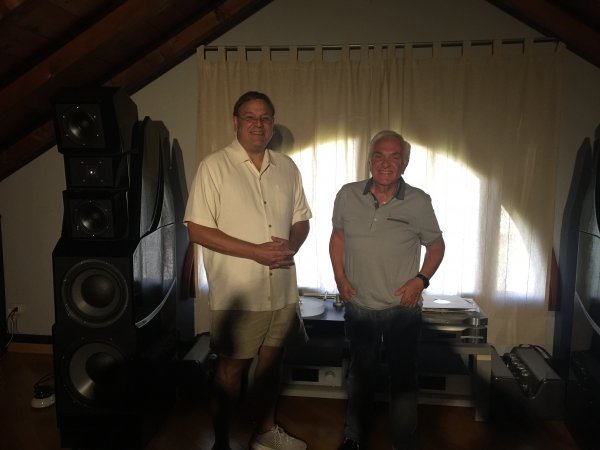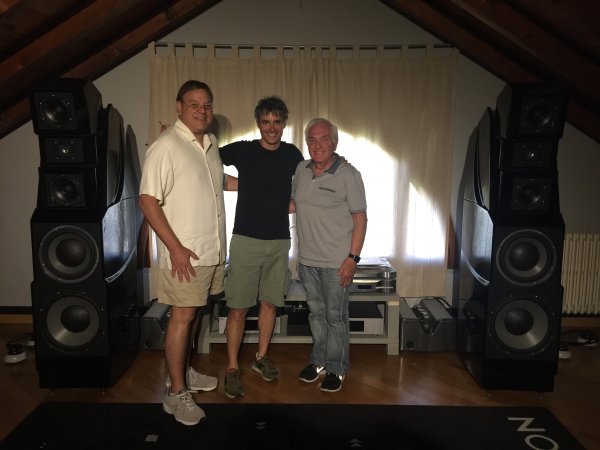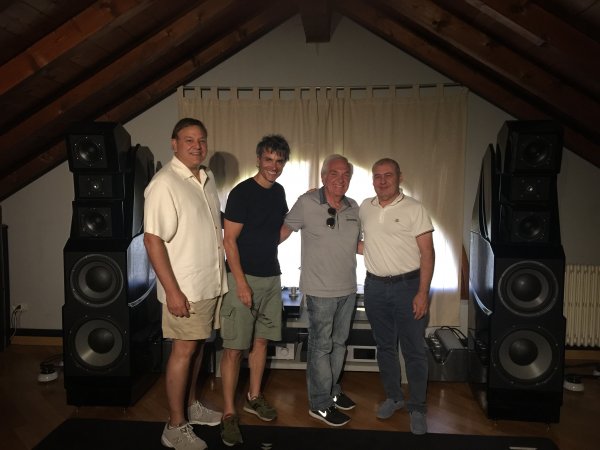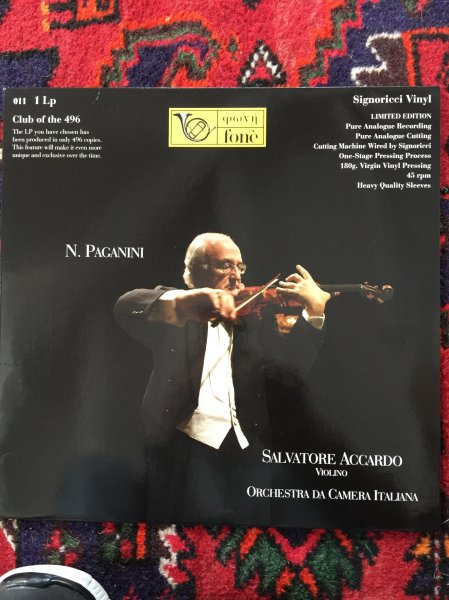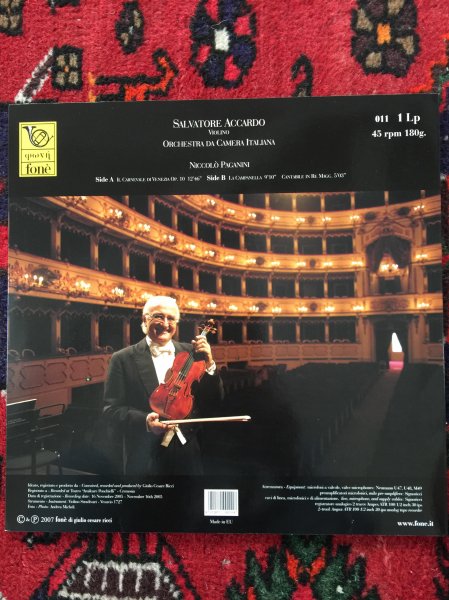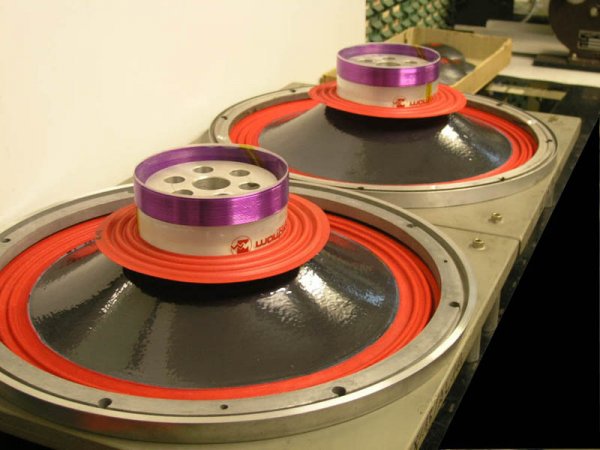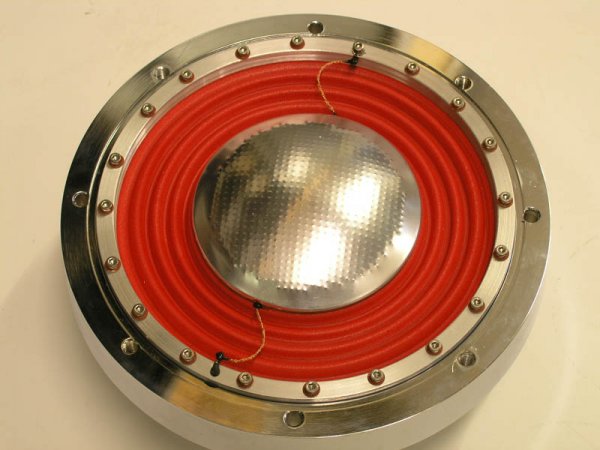The Two Amigos Ride Again- A 15,000 mile vacation of a lifetime
- Thread starter Steve williams
- Start date
You are using an out of date browser. It may not display this or other websites correctly.
You should upgrade or use an alternative browser.
You should upgrade or use an alternative browser.
We then quickly returned to Gian's house and finished the afternoon listening to some of his great R2R recordings. He had many samplers and demo tapes that were to die for as he played them through his Studer A80.
All in all Marty and I were an hour late to get back to Al Sorriso but nonetheless in time for dinner
Thank you Gian and Marco for this whirl wind tour of your systems. Albeit rushed Marty and I had an absolutely wonderful afternoon and it was great to hear this two very special systems. Your kindness and hospitality will always be remembered
Until the next time..........we loved our stay in your country
All in all Marty and I were an hour late to get back to Al Sorriso but nonetheless in time for dinner
Thank you Gian and Marco for this whirl wind tour of your systems. Albeit rushed Marty and I had an absolutely wonderful afternoon and it was great to hear this two very special systems. Your kindness and hospitality will always be remembered
Until the next time..........we loved our stay in your country
So there you haver the 15,000 mile two trip of a lifetime. It all started 15 years ago when this love of music brought Marty and I together and had it not been for that, this trip would never have occurred.
And how wonderful was it that after 14 days of travel we found a small window of opportunity to meet Gian and Marco who friendship and hospitality as well as a glimpse into their fine systems will never be forgotten
It was a long trip back for Cathy and I as everyone went direct through Malpensa whereas I had to connect through Frankfurt to catch our 12 hour flight home to LAX
The moral to that story is to stay hydrated and stay active while on such long flights or you might end up in the ER 5 hours after I got home from the pain of a kidney stone which took 2 days to pass
In spite of that it was the rip of a lifetime and a huge shout out once again to my good friend Marty who put this trip together all by himself. TBH Cathy and I just showed up as we knew that whatever Marty set his mind to would be wonderful in every way. Needless to say it was
If you're reading Marty, Cathy and I are in for your next planned trip 18 months from now for 2 weeks in New Zealand
FIN
And how wonderful was it that after 14 days of travel we found a small window of opportunity to meet Gian and Marco who friendship and hospitality as well as a glimpse into their fine systems will never be forgotten
It was a long trip back for Cathy and I as everyone went direct through Malpensa whereas I had to connect through Frankfurt to catch our 12 hour flight home to LAX
The moral to that story is to stay hydrated and stay active while on such long flights or you might end up in the ER 5 hours after I got home from the pain of a kidney stone which took 2 days to pass
In spite of that it was the rip of a lifetime and a huge shout out once again to my good friend Marty who put this trip together all by himself. TBH Cathy and I just showed up as we knew that whatever Marty set his mind to would be wonderful in every way. Needless to say it was
If you're reading Marty, Cathy and I are in for your next planned trip 18 months from now for 2 weeks in New Zealand
FIN
Absolutely a wonderful, once-in-a-lifetime experience. A pleasure to live vicariously through your colorful, detailed travelogue! In building WBF, you've built something even more important.
Lee
Lee
Fascinating, impressive and just stunning; I am so glad for all of you for this wonderful trip; we all just vicariously visited all these places, so big Thanks for these pictures! Sorry to hear about your ER trip Steve, but glad it's over. Regarding Fone, the one recording I have truly stands out, so I bet you heard great sounds at Marco's.
Thanks again for this wonderful thread!
Thanks again for this wonderful thread!
There is one more caveat I have discovered from this thread and it involves "adding images" to posts
For me it was a huge annoyance to see photos load sideways. Everyone has been giving me tutorials to correct this but let me share what I have found from this endeavor.
First off thanks to BruceD who helped reload some photos in correct orientation.
What people don't know its that when these photos were checked prior to posting they were ALL correctly oriented so I have no clue why some would load sideways but let me tell you the solution that I found
Prior to each post I move the 4-5 photos that will go with each post t the desktop. Im a Mac user so I then click on each photo on the desktop and even though they are all oriented correctly I use "Preview" to rotate Each picture 360 degrees and once done I save the image
Then I use that same image which essentially is oriented correctly and attach it to each post. Since doing that I get 100% accuracy with which the photos load. Seems crazy but I've been stymied trtying to figure why a photo which is aligned correctly will load sideways. Then for the heck of it I rotated each photo 360 degrees and saved it
Voila. I've never had a problem since with pictures loading sideways
For me it was a huge annoyance to see photos load sideways. Everyone has been giving me tutorials to correct this but let me share what I have found from this endeavor.
First off thanks to BruceD who helped reload some photos in correct orientation.
What people don't know its that when these photos were checked prior to posting they were ALL correctly oriented so I have no clue why some would load sideways but let me tell you the solution that I found
Prior to each post I move the 4-5 photos that will go with each post t the desktop. Im a Mac user so I then click on each photo on the desktop and even though they are all oriented correctly I use "Preview" to rotate Each picture 360 degrees and once done I save the image
Then I use that same image which essentially is oriented correctly and attach it to each post. Since doing that I get 100% accuracy with which the photos load. Seems crazy but I've been stymied trtying to figure why a photo which is aligned correctly will load sideways. Then for the heck of it I rotated each photo 360 degrees and saved it
Voila. I've never had a problem since with pictures loading sideways
Steve, I think the problem is with us users and how we expect things to render on the various phones and computers when we take pictures holding the phone upward vs sideways. To be more specific, if you take a picture with the phone standing up, it will render sideways - that's because in the picture's metadata it was marked as rotated 90 degrees - and if you take a picture with the phone sideways then it will render correctly.
Here are a couple of example pictures I just took:
Holding Upwards:
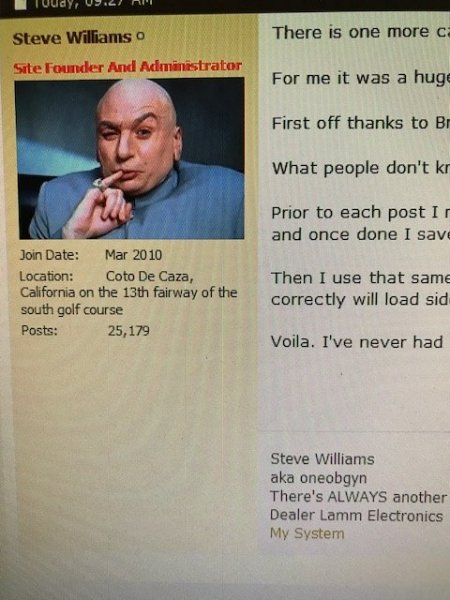
Holding Sideways:
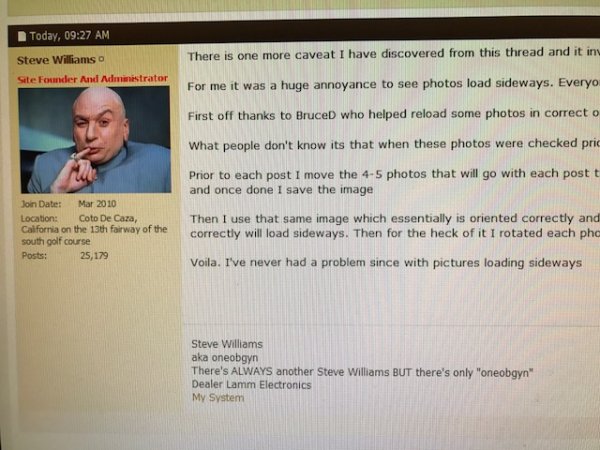
On our phones, both pictures render correctly because the phone automatically compensates for the original rotation, but desktop computers don't necessarily do that.
Here are a couple of example pictures I just took:
Holding Upwards:

Holding Sideways:

On our phones, both pictures render correctly because the phone automatically compensates for the original rotation, but desktop computers don't necessarily do that.
Dear Steve,i read only now this report.
Its an incredible report of your travel.But you always do incredible report that bring our mind out of our normal problems for a while.
I and Marco was very happy and honoured to meet you and Marty,2 very special people.
If you will come next time you will know other our friends with very good system
We hope one day to come to visit you with our family
Thanks for everything
Gianluigi
Its an incredible report of your travel.But you always do incredible report that bring our mind out of our normal problems for a while.
I and Marco was very happy and honoured to meet you and Marty,2 very special people.
If you will come next time you will know other our friends with very good system
We hope one day to come to visit you with our family
Thanks for everything
Gianluigi
Steve has already commented on our Italian hosts so I’d like to weigh in as well. To begin, what continues to strike me impressively is the genuine camaraderie and affection that audiophiles have for each other. Gianluigi and Marco continued to reinforce that impression. To be honest, it was embarrassing for us to continually decline their generosity during our limited time with them. ‘Let’s take you out to lunch”. No sorry, we can’t. “Let us take you out for drinks”. Uh, no, sorry. “Let’s stop for the best gelato you ever had”. Yer killin’ me Gianluigi, but, uh, no thanks. “Let’s go to your hotel and pick up your wives and we’ll drive to lake Orta which you really must see”. So sorry Gianluigi, but we simply do not have enough time. “I know you can’t take time for drinks so we brought the drinks to you”. OMG, to say these guys were the epitome of hospitality is an understatement. Audiophiles. Gotta love ‘em.
As Steve mentioned, our first stop was Gian’s. From the moment I walked into his listening room, I knew it would be a special experience. And it wasn’t the gear or the room that told me so. It was his music collection. I could have died and gone to heaven right there. It wasn’t the numbers that was impressive even though they certainly were (just a few thousand+ CD, LPs and assorted tapes), but the content. Gian is a jazz freak, as am I, and his collection left me drooling. IF there was a cut-out in the listening chair for a toilet, and somebody could hook me up to an IV for nutrition, I might never come out of that lair. This was the finest collection of jazz I have ever seen in one location. Exquisite taste on steroids, to say the least.
Although his speakers are hardly a household name in the US (or anywhere for that matter), they demonstrated some highly distinguished properties that were very impressive. As Gian rightly stated his system is fast. Very fast. Although this property is of course due in part to excellent electronics (all CH precision electronics), I couldn’t help but think of one thing in particular that may have a large contribution to the overall sound, which was the highly unusual crossover in the speakers. Most speaker crossovers (whether 1st, 2nd, 3rd, or 4th order) utilize electrolytic capacitors in their design. And the values needed are simply too large to use the more desirable film capacitors (i.e., polypropylene). When I designed crossovers in my younger days, I always used the best electrolytics available (Black Gate), but always wondered if it would be possible to use polyprops. I’m sure many others thought about this as well. The general answer is that constructing a crossover with polyprops would be essentially unrealistic as the number of caps need to approximate the values of a large electrolytic, would just not be feasible. Even if one used a large parallel/series array, such an array would not only be enormous and likely never fit comfortably in any speaker cabinet, but prohibitively expensive. In short, you’d have to be nuts to even try it. Well, that’s apparently what Gorgio Montagna did in designing his Spark 303 loudspeaker. See post #235 for a pic of the crossovers that used all polypropylene capacitors. By my count, the number of caps used in the bass/midrange crossover was at least 420!! (I could not see behind the group that was visible so I’m not sure of the final number. And also note the crossover units are cleverly mounted on elastomer mounts to minimize vibration.
The big advantage of using polypropylene capacitors in such a series/parallel array is that such an array will have a much lower ESR (equivalent series resistance) than any electrolytic. Simply put, decreased resistance (or reactance which is frequency dependent) translates to speed. And my guess is this is the great secret of the Montagna sound. (Did I mention “fast”!!). I’ve never seen this implemented before with any other speaker, and can’t help but wonder what improvements might be enjoyed in other speakers if such a crossover design were used?
After some enjoyable listening, we then went to Marco’s and my first thought after walking up the spiral staircase 2 floors to get to his listening room, was how the hell he got his Wilson X-1s there? It turns out he brought them in via a crane through a window! Talk about dedication.
Marco’s system used the same CH front end as Gian’s including the wonderful Bergmann Sindre turntable (everyone knows I’m a straight arm proponent ) with a key difference being Marco’s use of the Lyra Atlas (which I have never heard before and was impressed) vs the Air Tight Opus in Gian’s system. A key difference was that Marco used a lovely Vifa tube amp to drive his Wilson’s and in addition, he had some effective sidewall room treatment to prevent bounce and comb filter effects. These synergized to provide a highly musical sound. Then again, my bias has long been that the combination of SS and tube electronics is often very enjoyable, and Marco’s system demonstrates this very well. It was also a real treat to hear the Bergmann Sindre in 2 systems with identical front end electronics (CH Precision).
Then it was back to Gian’s for some tape playback. Sure, why not wait until I recover drooling from the earlier LP demos before you knock it out of the park with tape? Gian concluded the session by putting on a tape of the spectacular RCA’s Living Stereo “Witches Brew”. I had to be peeled off the floor when it was over.
I’ll conclude by saying the same thoughts I mentioned Initially. Audiophiles. The friendships I have made (and I suspect we have all made) that is what is special and lasting. Sure, we may disagree about this and that (hell, that’s why we get up in the morning!) but in the end, it’s the love of music and how we choose to reproduce it at home that are the ties that bind. I never fail to learn something all the time from each interaction. But more it’s the friendships that count. Gian and Marco couldn’t do enough for us and I still feel bad about declining their multiple invitations. With better planning, I’ll not make that mistake again on my next visit! And of course, I’d be delighted to host their visit if they should find themselves on this side of the pond. Fair warning however- I can’t provide the Italian food they are used to, but I can hold my own when it comes to not disappointing them with wines to drink!
As Steve mentioned, our first stop was Gian’s. From the moment I walked into his listening room, I knew it would be a special experience. And it wasn’t the gear or the room that told me so. It was his music collection. I could have died and gone to heaven right there. It wasn’t the numbers that was impressive even though they certainly were (just a few thousand+ CD, LPs and assorted tapes), but the content. Gian is a jazz freak, as am I, and his collection left me drooling. IF there was a cut-out in the listening chair for a toilet, and somebody could hook me up to an IV for nutrition, I might never come out of that lair. This was the finest collection of jazz I have ever seen in one location. Exquisite taste on steroids, to say the least.
Although his speakers are hardly a household name in the US (or anywhere for that matter), they demonstrated some highly distinguished properties that were very impressive. As Gian rightly stated his system is fast. Very fast. Although this property is of course due in part to excellent electronics (all CH precision electronics), I couldn’t help but think of one thing in particular that may have a large contribution to the overall sound, which was the highly unusual crossover in the speakers. Most speaker crossovers (whether 1st, 2nd, 3rd, or 4th order) utilize electrolytic capacitors in their design. And the values needed are simply too large to use the more desirable film capacitors (i.e., polypropylene). When I designed crossovers in my younger days, I always used the best electrolytics available (Black Gate), but always wondered if it would be possible to use polyprops. I’m sure many others thought about this as well. The general answer is that constructing a crossover with polyprops would be essentially unrealistic as the number of caps need to approximate the values of a large electrolytic, would just not be feasible. Even if one used a large parallel/series array, such an array would not only be enormous and likely never fit comfortably in any speaker cabinet, but prohibitively expensive. In short, you’d have to be nuts to even try it. Well, that’s apparently what Gorgio Montagna did in designing his Spark 303 loudspeaker. See post #235 for a pic of the crossovers that used all polypropylene capacitors. By my count, the number of caps used in the bass/midrange crossover was at least 420!! (I could not see behind the group that was visible so I’m not sure of the final number. And also note the crossover units are cleverly mounted on elastomer mounts to minimize vibration.
The big advantage of using polypropylene capacitors in such a series/parallel array is that such an array will have a much lower ESR (equivalent series resistance) than any electrolytic. Simply put, decreased resistance (or reactance which is frequency dependent) translates to speed. And my guess is this is the great secret of the Montagna sound. (Did I mention “fast”!!). I’ve never seen this implemented before with any other speaker, and can’t help but wonder what improvements might be enjoyed in other speakers if such a crossover design were used?
After some enjoyable listening, we then went to Marco’s and my first thought after walking up the spiral staircase 2 floors to get to his listening room, was how the hell he got his Wilson X-1s there? It turns out he brought them in via a crane through a window! Talk about dedication.
Marco’s system used the same CH front end as Gian’s including the wonderful Bergmann Sindre turntable (everyone knows I’m a straight arm proponent ) with a key difference being Marco’s use of the Lyra Atlas (which I have never heard before and was impressed) vs the Air Tight Opus in Gian’s system. A key difference was that Marco used a lovely Vifa tube amp to drive his Wilson’s and in addition, he had some effective sidewall room treatment to prevent bounce and comb filter effects. These synergized to provide a highly musical sound. Then again, my bias has long been that the combination of SS and tube electronics is often very enjoyable, and Marco’s system demonstrates this very well. It was also a real treat to hear the Bergmann Sindre in 2 systems with identical front end electronics (CH Precision).
Then it was back to Gian’s for some tape playback. Sure, why not wait until I recover drooling from the earlier LP demos before you knock it out of the park with tape? Gian concluded the session by putting on a tape of the spectacular RCA’s Living Stereo “Witches Brew”. I had to be peeled off the floor when it was over.
I’ll conclude by saying the same thoughts I mentioned Initially. Audiophiles. The friendships I have made (and I suspect we have all made) that is what is special and lasting. Sure, we may disagree about this and that (hell, that’s why we get up in the morning!) but in the end, it’s the love of music and how we choose to reproduce it at home that are the ties that bind. I never fail to learn something all the time from each interaction. But more it’s the friendships that count. Gian and Marco couldn’t do enough for us and I still feel bad about declining their multiple invitations. With better planning, I’ll not make that mistake again on my next visit! And of course, I’d be delighted to host their visit if they should find themselves on this side of the pond. Fair warning however- I can’t provide the Italian food they are used to, but I can hold my own when it comes to not disappointing them with wines to drink!
(...) Most speaker crossovers (whether 1st, 2nd, 3rd, or 4th order) utilize electrolytic capacitors in their design. And the values needed are simply too large to use the more desirable film capacitors (i.e., polypropylene). When I designed crossovers in my younger days, I always used the best electrolytics available (Black Gate), but always wondered if it would be possible to use polyprops. I’m sure many others thought about this as well. The general answer is that constructing a crossover with polyprops would be essentially unrealistic as the number of caps need to approximate the values of a large electrolytic, would just not be feasible.(...)
I was preparing a congratulation post to Steve for his great series, I will also make a note on Marty contribution.
Although true in the brave days when we were young DIY, the situation changed lot since them - most modern high-end speakers do not use electrolytics since many years ago, I replaced the 220 microfarad electrolytics of my vintage ESL63 with german polypropylene film capacitors twenty years ago! Bipolar electrolytic capacitors are really a no in speaker design - poor dielectric absorption, microphonic, low stability and limited lifetime. But as they are very low cost compared to equivalent film capacitors they are still being used when the budget is limited. Some manufacturers pot their crossovers, IMHO no wise person would pot an electrolytic capacitor! Availability of high value film capacitors is not a problem nowadays, except for price. I am just guessing, but IMHO the segmentation of the capacitors in the crossover can be due to sound quality objectives, not only for the type of capacitors.
Thanks to everyone, particularly to Steve, for your great reports on your trip and on the systems of the Lombardia region!
Last edited:
Dear Marty,
i and Marco were happy and excited of your and Steve visit,so we wanted do our best for you.
Than Italian people has also good hospitality.
We hope meet again next time.
Montagna speaker is fast not only for network but mainly for drivers because use a very good magnet in Maxalco,and the part of the driver,voice coil,cones and suspension are very light,so this is the secret.Some years ago i listen this speaker with a normal network and the sound was fast similar,now with this network increase a little.
Happy you liked this speaker.
Also CH electronics i found fantastic.I had Kondo before,very very good,but CH in comparison was more natural with very fast and dynamic sound.
Happy to know you,hope to meet again
Gianluigi
i and Marco were happy and excited of your and Steve visit,so we wanted do our best for you.
Than Italian people has also good hospitality.
We hope meet again next time.
Montagna speaker is fast not only for network but mainly for drivers because use a very good magnet in Maxalco,and the part of the driver,voice coil,cones and suspension are very light,so this is the secret.Some years ago i listen this speaker with a normal network and the sound was fast similar,now with this network increase a little.
Happy you liked this speaker.
Also CH electronics i found fantastic.I had Kondo before,very very good,but CH in comparison was more natural with very fast and dynamic sound.
Happy to know you,hope to meet again
Gianluigi
Thanks Gian. BTW, I went home and tried to buy a copy of "Sounds unheard of" by Shelley Mann which sounded great on your system, but learned it was out of print. I called Analogue Productions and just learned it is coming back to their catalogue. Finally, for anyone interested in understanding the revolution in wine that occurred in Barolo over the past 30 years or so, I highly recommend the documentary "Barolo Boys", which is available for rent on Amazon Prime.
Last edited:
Similar threads
- Replies
- 11
- Views
- 2K
- Replies
- 0
- Views
- 494
- Replies
- 100
- Views
- 13K
- Replies
- 37
- Views
- 6K
- Replies
- 2
- Views
- 908
| Steve Williams Site Founder | Site Owner | Administrator | Ron Resnick Site Owner | Administrator | Julian (The Fixer) Website Build | Marketing Managersing |


